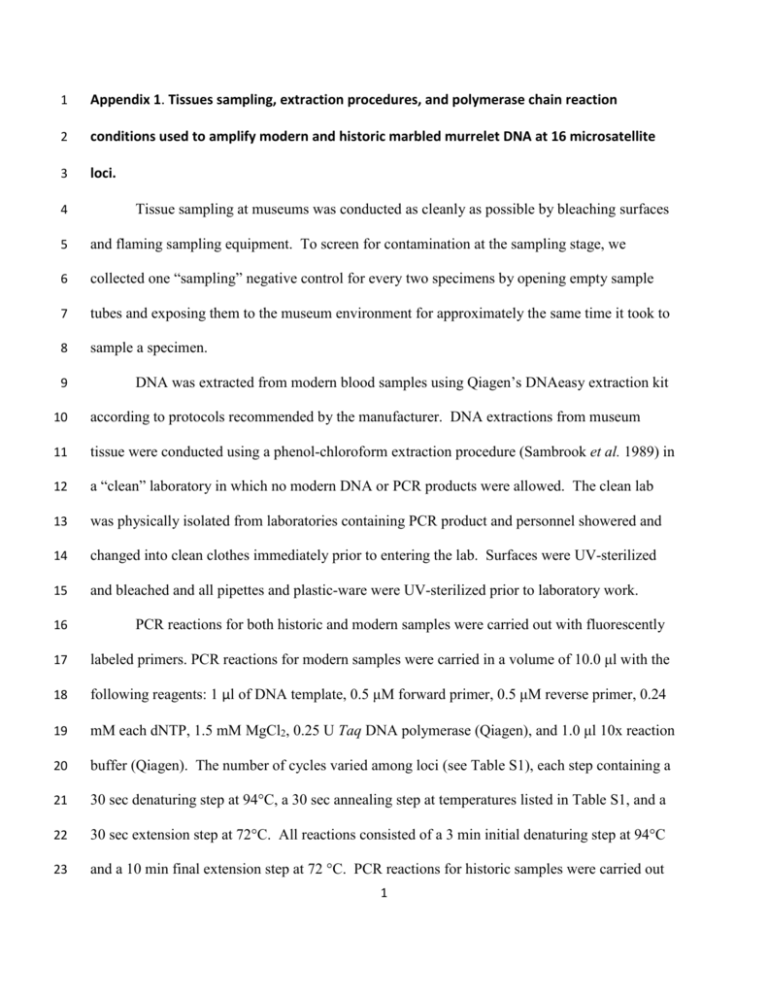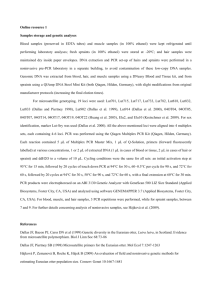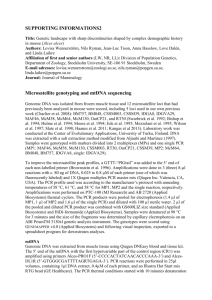Appendix 1 - Proceedings of the Royal Society B
advertisement

1 Appendix 1. Tissues sampling, extraction procedures, and polymerase chain reaction 2 conditions used to amplify modern and historic marbled murrelet DNA at 16 microsatellite 3 loci. 4 Tissue sampling at museums was conducted as cleanly as possible by bleaching surfaces 5 and flaming sampling equipment. To screen for contamination at the sampling stage, we 6 collected one “sampling” negative control for every two specimens by opening empty sample 7 tubes and exposing them to the museum environment for approximately the same time it took to 8 sample a specimen. 9 DNA was extracted from modern blood samples using Qiagen’s DNAeasy extraction kit 10 according to protocols recommended by the manufacturer. DNA extractions from museum 11 tissue were conducted using a phenol-chloroform extraction procedure (Sambrook et al. 1989) in 12 a “clean” laboratory in which no modern DNA or PCR products were allowed. The clean lab 13 was physically isolated from laboratories containing PCR product and personnel showered and 14 changed into clean clothes immediately prior to entering the lab. Surfaces were UV-sterilized 15 and bleached and all pipettes and plastic-ware were UV-sterilized prior to laboratory work. 16 PCR reactions for both historic and modern samples were carried out with fluorescently 17 labeled primers. PCR reactions for modern samples were carried in a volume of 10.0 μl with the 18 following reagents: 1 μl of DNA template, 0.5 μM forward primer, 0.5 μM reverse primer, 0.24 19 mM each dNTP, 1.5 mM MgCl2, 0.25 U Taq DNA polymerase (Qiagen), and 1.0 μl 10x reaction 20 buffer (Qiagen). The number of cycles varied among loci (see Table S1), each step containing a 21 30 sec denaturing step at 94°C, a 30 sec annealing step at temperatures listed in Table S1, and a 22 30 sec extension step at 72°C. All reactions consisted of a 3 min initial denaturing step at 94°C 23 and a 10 min final extension step at 72 °C. PCR reactions for historic samples were carried out 1 24 in a volume of 12.5μl with the following reagents: approximately 1.5-5 μl of DNA template, 0.5 25 μM forward primer, 0.5 μM reverse primer, 0.24 mM each dNTP, 0.25 μl 100x BSA, 2.0-3.0 26 mM MgCl2, and 0.625 U Taq DNA polymerase (Roche), 1.25 μl 10x reaction buffer (Roche). 27 The number of cycles varied among loci (see Table S1), each step containing a 30-45 sec 28 denaturing step at 94°C, a 30-45 sec annealing step at temperatures listed in Appendix S1, and a 29 30-45 sec extension step at 72°C. All reactions consisted of a 5 min initial denaturing step at 30 94°C and a 10 min final extension step at 72 °C. Eleven negative controls were included per 96- 31 well PCR plate including negative controls from extractions described above. Amplification 32 products from both modern and historic sources were sized by capillary electrophoresis on an 33 ABI 3730 sequencer (Applied Biosystems, Inc.), and alleles were scored using program 34 GENEMAPPER Ver. 4.0 software (Applied Biosystems, Inc.). 35 For historic samples, primers for three loci were modified from Rew et al. (2006) to 36 reduce the size of amplicons because we had limited success amplifying DNA fragments greater 37 than 200 base pairs (see Table S1). Each allele detected in modern samples was amplified at 38 least once with the both the original and modified primers in a subsample of the modern samples 39 to cross-reference allele scores between time periods. 40 Historic samples were amplified at least twice at each locus to assess the repeatability of 41 allele calling and estimate the rate of allelic dropout (Taberlet et al. 1996; Wandeler et al. 2007). 42 Single-locus genotypes that did not agree between amplifications were amplified again until 43 allele scoring appeared unambiguous. Ninety-four percent of historic genotypes agreed between 44 the first and second amplifications, and ambiguous genotypes were generally resolvable after a 45 third amplification. Ninety-seven percent of single-locus genotypes derived from 24 randomly 46 selected and re-extracted historic samples were the same as derived from the original 2 47 amplifications. The 3% of genotypes that did not agree appeared to be the result of allelic 48 dropout in the positive controls, and not due to genotyping errors in the original dataset. 49 50 REFERENCES 51 Rew, M. B., Peery, M. Z., Beissinger, S. R., Berube, M., Lozier, J. D., Rubidge, E. M. & 52 Palsboll, P. J. 2006 Cloning and characterization of 29 tetranucleotide and two 53 dinucleotide polymorphic microsatellite loci from the endangered marbled murrelet 54 (Brachyramphus marmoratus). Molecular Ecology Notes 6, 241-244. 55 56 57 Sambrook, J., Fritsch, E. F. & Maniatis, T. 1989 Molecular Cloning: A Laboratory Manual. Cold Spring Harbor, NY Cold Spring Harbor Laboratory Press. Taberlet, P., Griffin, S., Goossens, B., Questiau, S., Manceau, V., Escaravage, N., Waits, L. P. & 58 Bouvet, J. 1996 Reliable genotyping of samples with very low DNA quantities using 59 PCR. Nucleic Acids Research 24, 3189-3194. 60 61 Wandeler, P., Hoeck, P. E. A. & Keller, L. F. 2007 Back to the future: museum specimens in population genetics. Trends in Ecology & Evolution 22, 634-642. 62 63 3








